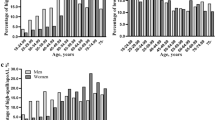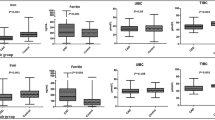Abstract
Numerous studies have demonstrated that tissue deposition of iron following prolonged high dose of oral supplementation for treatment of iron deficiency anemia (IDA) leads to body iron overload and oxidative stress, which starts the process of atherosclerosis. This study aimed to determine the effect of iron supplementation in combination with docosahexaenoic acid (DHA) on the cardiovascular disease risk based on paraoxonase-1 (PON-1), high-sensitivity C-reactive protein (hs-CRP), and ApoB/ApoA-I ratio in women with IDA. In this randomized controlled trial, 76 women with IDA, aged 15–45 years, were included. The patients were randomly assigned to receive 500 mg of DHA supplement or placebo with an iron tablet, once daily for 12 weeks. The participants were assessed by measurement of the serum iron, ferritin, PON-1, hs-CRP levels, and the ApoB/ApoA-I ratio at the beginning and end of study. Serum hs-CRP decreased in the DHA-supplemented group (p = 0.036), and ApoA-I decreased in the placebo group (p = 0.013). No significant difference was detected for the serum PON-1 concentration and the ApoB/ApoA-I ratio in two groups. Iron supplementation combined with DHA may have favorable effects on serum hs-CRP in women with IDA.
Similar content being viewed by others
References
Mendes JF, Arruda SF, Siqueira EM, Ito MK, Silva EF (2009) Iron status and oxidative stress biomarkers in adults: a preliminary study. Nutrition 25:379–384
Schümann K, Ettle T, Szegner B, Elsenhans B, Solomons NW (2007) On risks and benefits of iron supplementation recommendations for iron intake revisited. J Trace Elem Med Biol 21(3):147–168
Schümann K (2001) Safety aspects of iron in food. Ann Nutr Metab 45(3):91–101
Yip R (2002) Iron supplementation: country level experiences and lessons learned. J Nutr 132:859–861
UNICEF (1999) Preventing iron deficiency in women and children. Technical Workshop, New York, pp 13–17 [Chapter 2]
Krishnamoorthy PM, Prabu RN, Mohan DM, Sabitha N, Janakarajan VN, Natesan B (2010) Role of oxidative stress and antioxidants in children with IDA. Rev Glob Med Healthc Res 395
Buijsse B, Feskens EJ, Moschandreas J, Jansen EH, Jacobs DR Jr, Kafatos A et al (2007) Oxidative stress and iron and antioxidant status in elderly men: differences between the Mediterranean south (Crete) and northern Europe (Zutphen). Eur J Cardiovasc Prev Rehabil 14:495–500
Valko M, Rhodes CJ, Moncol J, Izakovic M, Mazur M (2006) Free radicals, metals and antioxidants in oxidative stress-induced cancer. Chem Biol Interact 160:1–40
Liu K, Kaffes AJ (2012) Iron deficiency anaemia: a review of diagnosis, investigation and management. Eur J Gastroenterol Hepatol 24:109–116
Pena-Rosas JP, De-Regil LM, Dowswell T, Viteri FE (2012) Intermittent oral iron supplementation during pregnancy. Cochrane Database Syst Rev 7, CD009997
Erichsen K, Hausken T, Berge R, Ulvik R, Berstad A (1998) Effect of oral iron therapy on antioxidant defence in active Crohn’s disease. Digestion 59(31), FOLM1287
Galaris D, Pantopoulos K (2008) Oxidative stress and iron homeostasis: mechanistic and health aspects. Crit Rev Clin Lab Sci 45:1–23
Lopez-Huertas E (2010) Health effects of oleic acid and long chain omega-3 fatty acids (EPA and DHA) enriched milks. A review of intervention studies. Pharmacol Res 61(3):200–207
Shidfar F, Keshavarz A, Hosseyni S, Ameri A, Yarahmadi S (2008) Effects of omega-3 fatty acid supplements on serum lipids, apolipoproteins, and malondialdehyde in type 2 diabetes patients. East Mediterr Health J 14(2):305–313
Das UN (2006) Essential fatty acids—a review. Curr Pharm Biotechnol 7(6):467–482
Dupertuis YM, Meguid MM, Pichard C (2007) Colon cancer therapy: new perspectives of nutritional manipulations using polyunsaturated fatty acids. Curr Opin Clin Nutr Metab Care 4:427–432
Shoji H, Franke C, Campoy C, Rivero M, Demmelmair H, Koletzko B (2006) Effect of docosahexaenoic acid and eicosapentaenoic acid supplementation on oxidative stress levels during pregnancy. Free Radic Res 40(4):379–384
Shidfar F, Heydari I, Hajimiresmaiel SJ, Hosseini S, Shidfar S, Amiri F (2012) The effects of cranberry juice on serum glucose, apoB, apoA-I, Lp(a), and Paraoxonase-1 activity in type 2 diabetic male patients. J Res Med Sci 17(4):355–360
Calabresi L, Villa B, Canavesi M, Sirtori CR, James RW, Bernini F et al (2004) An omega-3 polyunsaturated fatty acid concentrate increases plasma high-density lipoprotein 2 cholesterol and paraoxonase levels in patients with familial combined hyperlipidemia. Metabolism 53(2):153–158
Lien EL (2009) Toxicology and safety of DHA. Prostaglandins Leukot Essent Fat Acids 81(2):125–132
Vaquero MP, Veldhuizen M, Sarria B (2001) Consumption of an infant formula supplemented with long chain polyunsaturated fatty acids and iron metabolism in rats. Innovative Food Sci Emerg Technol 2(3):211–217
Woodman RJ, Mori TA, Burke V, Puddey IB, Watts GF, Best JD, Beilin LJ (2003) Docosahexaenoic acid but not eicosapentaenoic acid increases LDL particle size in treated hypertensive type 2 diabetic patients. Diabetes Care 26(1):253
McAnulty SR, Nieman DC, Fox-Rabinovich M, Duran V, McAnulty LS, Henson DA et al (2010) Effect of n-3 fatty acids and antioxidants on oxidative stress after exercise. Med Sci Sports Exerc 42(9):1704
Petersson H, Risérus U, McMonagle J, Gulseth HL, Tierney AC, Morange S et al (2010) Effects of dietary fat modification on oxidative stress and inflammatory markers in the LIPGENE study. Br J Nutr 104(09):1357–1362
Wilkinson P, Leach C, Ah-Sing EE, Hussain N, Miller GJ, Millward DJ et al (2005) Influence of alpha-linolenic acid and fish-oil on markers of cardiovascular risk in subjects with an atherogenic lipoprotein phenotype. Atherosclerosis 181(1):115
Ferretti G, Bacchetti T (2011) Effect of dietary lipids on paraoxonase-1 activity and gene expression. Nutr Metab Cardiovasc Dis
Lee DH, Jacobs DR (2005) Association between serum gamma-glutamyltransferase and C-reactive protein. Atherosclerosis 178(2):327–330
Kooshki A, Taleban FA, Tabibi H, Hedayati M (2011) Effects of omega-3 fatty acids on serum lipids, lipoprotein (a), and hematologic factors in hemodialysis patients. Ren Fail 33(9):892–898
Potsch AA, Siqueira Filho AG, Rangel Tura B, Gamarski R, Bassan R, Nogueira MV et al (2006) C-Reactive protein diagnostic and prognostic value in patients presenting at the emergency room with chest pain. Arq Bras Cardiol 87(3):275–280
Ceron JJ, Tecles F, Tvarijonaviciute A (2014) Serum paraoxonase 1 (PON1) measurement: an update. BMC Vet Res 10:74
Calzada C, Colas R, Guillot N, Guichardant M, Laville M, Véricel E et al (2010) Subgram daily supplementation with docosahexaenoic acid protects low-density lipoproteins from oxidation in healthy men. Atherosclerosis 208(2):467–472
Donnelly SM, Ali MA, Churchill DN (1992) Effect of n-3 fatty acids from fish oil on hemostasis, blood pressure, and lipid profile of dialysis patients. J Am Soc Nephrol 2(11):1634–1639
Micallef MA, Munro IA, Garg ML (2009) An inverse relationship between plasma n-3 fatty acids and C-reactive protein in healthy individuals. Eur J Clin Nutr 63(9):1154–1156
Balk EM, Lichtenstein AH, Chung M, Kupelnick B, Chew P, Lau J (2006) Effects of omega-3 fatty acids on serum markers of cardiovascular disease risk: a systematic review. Atherosclerosis 189(1):19–30
Pischon T, Hankinson SE, Hotamisligil GS, Rifai N, Willett WC, Rimm EB (2003) Habitual dietary intake of n-3 and n-6 fatty acids in relation to inflammatory markers among US men and women. Circulation 108(2):155–160
Tayyebi-Khosroshahi H, Houshyar J, Dehgan-Hesari R, Alikhah H, Vatankhah AM, Safaeian AR et al (2012) Effect of treatment with omega-3 fatty acids on C-reactive protein and tumor necrosis factor-alphaa in hemodialysis patients. Saudi J Kidney Dis Transpl 23(3):500
Geelen A, Brouwer IA, Schouten EG, Kluft C, Katan MB, Zock PL (2004) Intake of n-3 fatty acids from fish does not lower serum concentrations of C-reactive protein in healthy subjects. Eur J Clin Nutr 58(10):1440–1442
Madsen T, Christensen JH, Blom M, Schmidt EB (2003) The effect of dietary n-3 fatty acids on serum concentrations of C-reactive protein: a dose–response study. Br J Nutr 89(04):517–522
Chan DC, Watts GF, Barrett PH, Beilin LJ, Mori TA (2002) Effect of Atorvastatin and fish oil on plasma high-sensitivity C-reactive protein concentrations in individuals with visceral obesity. Clin Chem 48(6):877–883
Hartweg J, Farmer AJ, Perera R, Holman RR, Neil HA (2007) Meta-analysis of the effects of n-3 polyunsaturated fatty acids on lipoproteins and other emerging lipid cardiovascular risk markers in patients with type 2 diabetes. Diabetologia 50(8):1593–1602
Rodriguez MC, Sáiz MP, Muntané J, Mitjavila MT (1996) Fatty acid composition of erythrocyte membranes affects iron absorption in rats. J Nutr 126(12):3109–3117
Chan DC, Watts GF, Mori TA, Barrett PH, Redgrave TG, Beilin LJ (2003) Randomized controlled trial of the effect of n–3 fatty acid supplementation on the metabolism of apolipoprotein B-100 and chylomicron remnants in men with visceral obesity. Am J Clin Nutr 77(2):300–307
Eftekhari MH, Mozaffari-Khosravi H, Shidfar F, Zamani A (2013) Relation between body iron status and cardiovascular risk factors in patients with cardiovascular disease. Int J Prev Med 4(8):911–916
Acknowledgments
Authors are very thankful to the patients who participated in the study, Tooba clinic and Razi hospital nurses and physicians for their valuable help.
Conflict of interest
The authors declare that there are no conflicts of interest.
Author information
Authors and Affiliations
Corresponding author
Rights and permissions
About this article
Cite this article
Shidfar, F., Amani, S., Vafa, M. et al. Effects of Iron Supplementation With and Without Docosahexaenoic Acid on the Cardiovascular Disease Risk Based on Paraoxonase-1, hs-CRP, and ApoB/ApoA-I Ratio in Women with Iron Deficiency Anemia. Biol Trace Elem Res 169, 34–40 (2016). https://doi.org/10.1007/s12011-015-0383-7
Received:
Accepted:
Published:
Issue Date:
DOI: https://doi.org/10.1007/s12011-015-0383-7




